This is called Additional paid in capital in US GAAP terminology but, additional paid in capital is not limited to share premium. It is a very broad concept and includes tax related and conversion related adjustments. When you hear investors, accountants, or analysts talk about reserves, they might not be talking about the reserves shown in the shareholders' equity section of the balance sheet. Rather, certain types of accounting transactions require reserves to keep the income statement as close to reality as possible. "Reserves on the balance sheet" is a term used to refer to the shareholders' equity section of the balance sheet.
- This surplus represents the additional value that investors have contributed to the company.
- A surplus, generally speaking, occurs when there is more of something than is needed.
- Capital surplus, also known as “additional paid-in capital” or “share premium,” is an account in a company’s shareholders’ equity section on the balance sheet.
- Steven’s goal is to assist and counsel his clients to protect them and their loved ones.
It provides insight into a company’s financial flexibility, strength, and potential for future growth. Investors, analysts, and stakeholders consider capital surplus as a key indicator of a company’s financial health and its ability to create value for shareholders over the long term. Capital surplus is typically disclosed separately from other components of equity, such as retained earnings or other comprehensive income. This transparency allows stakeholders to understand the historical contributions made by shareholders and the availability of additional capital that can be utilized for future growth or other corporate purposes. Revaluation of assets refers to the process of assessing and adjusting the recorded value of a company’s assets to reflect their current fair market value. This reassessment is done periodically to ensure that the asset values presented on the balance sheet are reflective of their true worth.
It is important to note that while the par value remains constant over time, the capital surplus can fluctuate based on various factors, such as stock buybacks, dividend payments, or changes in the market value of assets. Capital surplus, also known as additional paid-in capital, is the amount of funds that a company raises through stock issuances or revaluation of assets, beyond the par value of the stock. Par value refers to the nominal or face value assigned to each share of stock when it is first issued.
Because after deduction of costs from gross income, "It is hard to say exactly how much must be reinvested to maintain the size of the capital stock". Ultimately, Thurow implies, the tax department is the arbiter of the profit volume, because it determines depreciation allowances and other costs which capitalists may annually deduct in calculating taxable gross income. The term capital as used in provisions of law relating to the capital of national banks shall include the amount of common stock outstanding and unimpaired plus the amount of perpetual preferred stock outstanding and unimpaired. A surplus describes the amount of an asset or resource that exceeds the portion that's actively utilized. A surplus can refer to a host of different items, including income, profits, capital, and goods.
When does capital surplus arise?
Capital surplus is used to account for that amount which a firm raises in excess of the par value (nominal value) of the shares (common stock).. Somebody has tried to be smart on wikipedia and have done the calculations without much explanation. The accounting treatment of capital surplus depends on the financial reporting framework followed by a company, such as Generally Accepted Accounting Principles (GAAP) or International Financial Reporting Standards (IFRS). However, there are some general principles that guide the accounting treatment of capital surplus. Capital surplus represents the equity a company has built up through various means. It is a reflection of the investors’ willingness to pay more for a share of stock than its initial value.
Stock issuances, stock buybacks, dividend payments, and revaluation of assets are the key drivers that contribute to the creation and fluctuations of capital surplus. The issuance of stock allows companies to raise funds for various purposes, such as financing growth initiatives, expanding operations, acquiring other companies, or strengthening the company’s balance sheet. The capital surplus generated from stock issuances provides the company with additional financial flexibility and resources to pursue these objectives.
Components of Capital Surplus
Most companies use the share premium account to record the additional amount. During the last decade, public companies have repurchased significant amounts of their common stock through share repurchase programs. In the future, to raise capital, these businesses could reissue treasury stock. Capital surplus, or share premium, of commonly refers to the surplus arising after common bearings is sold for more than its par value. Capital surplus includes equity or net worth otherwise not classifiable as capital hoard or retained earnings. Thurow goes on to note that "When it comes to actually measuring profits, some difficult accounting issues arise." Why?
What Are Reserves on the Balance Sheet?
This transaction is not recorded in gross product measures (after all, it isn't new production), nevertheless a surplus-value is obtained from it. Marx occasionally refers to this kind of profit as profit upon alienation, alienation being used here in the juridical, not sociological sense. By implication, if we just focused on surplus-value newly created in production, we would underestimate total surplus-values realised as income in a country. This becomes obvious if we compare census estimates of income & expenditure with GDP data. Marx distinguished sharply between value and price, in part because of the sharp distinction he draws between the production of surplus-value and the realisation of profit income (see also value-form). Output may be produced containing surplus-value (valorisation), but selling that output (realisation) is not at all an automatic process.
(1) If a company issues shares at a premium, whether for cash or otherwise, a sum equal to the aggregate amount or value of the premiums on those shares shall be transferred to an account called "the share premium account". If ABC Company were to sell 100 shares of its $1 par value common stock for $9 per share, it would record $100 of the $900 in total proceeds in the Common Stock account and $800 in the Additional Paid-in Capital account. In earlier days, the $800 entry to the Additional Paid-In Capital account would instead have been made to the Capital Surplus account.
Examples and Applications of Capital Surplus
Firstly, they can signal to the market that the company’s management believes its shares are undervalued, leading to increased investor confidence. Additionally, by reducing the number of shares outstanding, stock buybacks can lead to an increase in earnings per share, which may attract more investment from shareholders. Issuing stock is considered a significant milestone for a company, as it opens up opportunities for growth and expansion. It allows the company to tap into the capital market and attract investors who believe in the company’s potential.
What Is Funds Overflow? Interpretation and How It Can Be Created
Stock buybacks can be a strategic financial move undertaken by companies to manage their capital structure and allocate excess cash. When companies buy back their shares and sell them later, they can charge more than their buyback value. For companies, however, it creates equity reserves received above the shares’ par value. Most companies maintain this account as a part of the accounting requirements to separate the additional amounts. However, accounting standards require them to separate them into several accounts. (3) Subject to this, the provisions of this Act relating to the reduction of a company's share capital apply as if the share premium account were part of its paid up share capital.
Sellers are constantly competing with other vendors to move as much product as possible, at the best value. If demand for the product spikes, the vendor offering the lowest price may run out of supply, which tends amended tax return to result in general market price increases, causing a producer surplus. The opposite occurs if prices go down, and supply is high, but there is not enough demand, consequently resulting in a consumer surplus.
Capital Surplus vs. Retained Earnings
Some other scenarios for triggering a capital surplus include when the Government donates a piece of land to the company. Capital stock can serve as an umbrella term for more specific classifications, such as acquired surplus, additional paid-in-capital, donated surplus, or reevaluation surplus (which could pop up during appraisals). Capital stock capacity serve since one protective term for continue specific classifications, such as acquired surplus, further paid-in-capital, granted superfluity, or reevaluation surplus (which could pop up during appraisals).
相关推荐: Difference between Property Appraisal and Valuation
Once the valuation is done, you will receive a detailed written report depicting the value of the property and other related infor…



